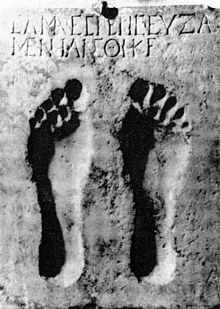
Ma was a local goddess at Comana in Cappadocia. Her name Ma means "Mother", and she also had the epithets "Invincible" and "Bringer of Victory". [1]

Ma was a local goddess at Comana in Cappadocia. Her name Ma means "Mother", and she also had the epithets "Invincible" and "Bringer of Victory". [1]
Ma has been interpreted as a mother goddess, but at the same time as a warrior goddess, as her name and epithets indicate both. [1]
She was associated with the transition of adulthood of both genders, and sacred sex rituals were practiced during her biennial festivals. [1]
Ma was also seen as a moon goddess, being associated with the Anatolia moon god Mēn, with a temple estate dedicated to Mēn Pharnakou and Selene at Ameria, near Cabira, in the Kingdom of Pontus, being an attempt to counter-balance the influence of the Moon goddess Ma of Comana.
Ma has been identified with a number of other deities, indicating her function. She has been compared to Cybele and Bellona. The ancient Greeks compared Ma to the goddess Enyo and Athena Nicephorus. [2] Plutarch likened her with Semele and Athena. [1] Ma was introduced and worshiped in Macedonia together with other foreign deities. [3] [4]
Ma-Enyo, a fusion between the Anatolian goddess Ma and the Greek Goddess, Enyo, was considered the great west Asian nature-goddess, with Comana's temple and its fame in ancient times as the place where the rites of this, a variety of the nature goddess, were celebrated with much solemnity.
Ma is described as a local Anatolian goddess, with her cult centered around her temple at Komana in Cappadocia. Her temple in Comana is described by Strabo. [5]

In ancient Greek religion and mythology, Artemis is the goddess of the hunt, the wilderness, wild animals, nature, vegetation, childbirth, care of children, and chastity. In later times, she was identified with Selene, the personification of the Moon. She was often said to roam the forests and mountains, attended by her entourage of nymphs. The goddess Diana is her Roman equivalent.

Diana is a goddess in Roman and Hellenistic religion, primarily considered a patroness of the countryside and nature, hunters, wildlife, childbirth, crossroads, the night, and the Moon. She is equated with the Greek goddess Artemis, and absorbed much of Artemis' mythology early in Roman history, including a birth on the island of Delos to parents Jupiter and Latona, and a twin brother, Apollo, though she had an independent origin in Italy.
Hecate is a goddess in ancient Greek religion and mythology, most often shown holding a pair of torches, a key, or snakes, or accompanied by dogs, and in later periods depicted as three-formed or triple-bodied. She is variously associated with crossroads, entrance-ways, night, light, magic, witchcraft, the Moon, knowledge of herbs and poisonous plants, graves, ghosts, necromancy, and sorcery. Her earliest appearance in literature was in Hesiod's Theogony in the 8th century BCE as a goddess of great honour with domains in sky, earth, and sea. Her place of origin is debated by scholars, but she had popular followings amongst the witches of Thessaly and an important sanctuary among the Carian Greeks of Asia Minor in Lagina. Her oldest known representation was found in Selinunte, in Sicily.
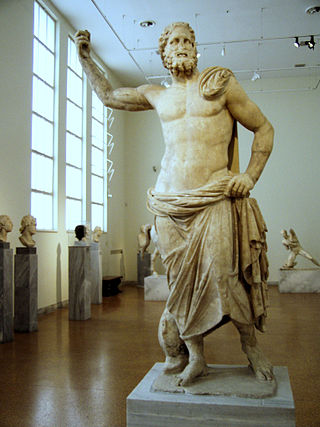
Poseidon is one of the Twelve Olympians in ancient Greek religion and mythology, presiding over the sea, storms, earthquakes and horses. He was the protector of seafarers and the guardian of many Hellenic cities and colonies. In pre-Olympian Bronze Age Greece, Poseidon was venerated as a chief deity at Pylos and Thebes, with the cult title "earth shaker"; in the myths of isolated Arcadia, he is related to Demeter and Persephone and was venerated as a horse, and as a god of the waters. Poseidon maintained both associations among most Greeks: he was regarded as the tamer or father of horses, who, with a strike of his trident, created springs. His Roman equivalent is Neptune.

In ancient Greek religion and mythology, Hestia is the virgin goddess of the hearth and the home. In myth, she is the firstborn child of the Titans Cronus and Rhea, and one of the Twelve Olympians.
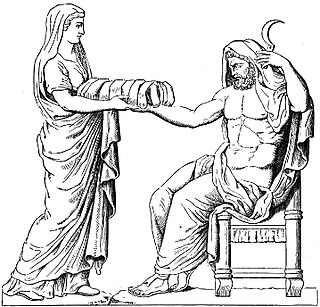
Rhea or Rheia is a mother goddess in ancient Greek religion and mythology, the Titaness daughter of the earth goddess Gaia and the sky god Uranus, himself a son of Gaia. She is the older sister of Cronus, who was also her consort, and the mother of the five eldest Olympian gods and Hades, king of the underworld.

Agdistis is a deity of Greek, Roman, and Anatolian mythology who has both male and female reproductive organs. It was closely associated with the Phrygian goddess Cybele.

Britomartis was a Greek goddess of mountains and hunting, who was primarily worshipped on the island of Crete. She was sometimes believed to be an oread, or a mountain nymph, but she was often conflated or syncretized with Artemis and Aphaea, the "invisible" patroness of Aegina. She is also known as Dictynna or as a daughter of Dictynna.
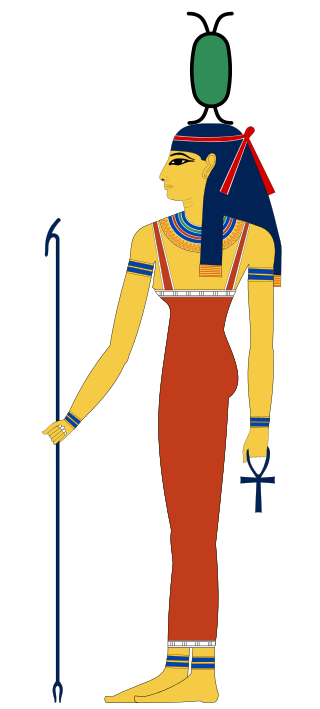
Neith was an early ancient Egyptian deity. She was said to be the first and the prime creator, who created the universe and all it contains, and that she governs how it functions. She was the goddess of the cosmos, fate, wisdom, water, rivers, mothers, childbirth, hunting, weaving, and war.

Juno was an ancient Roman goddess, the protector and special counsellor of the state. She was equated to Hera, queen of the gods in Greek mythology and a goddess of love and marriage. A daughter of Saturn and Ops, she was the sister and wife of Jupiter and the mother of Mars, Vulcan, Bellona, Lucina and Juventas. Like Hera, her sacred animal was the peacock. Her Etruscan counterpart was Uni, and she was said to also watch over the women of Rome. As the patron goddess of Rome and the Roman Empire, Juno was called Regina ("Queen") and was a member of the Capitoline Triad, centered on the Capitoline Hill in Rome, and also including Jupiter, and Minerva, goddess of wisdom.
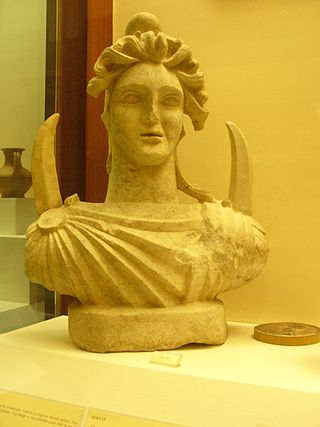
Mēn was a lunar god worshipped in the western interior parts of Anatolia. He is attested in various localized variants, such as Mēn Askaenos in Antioch in Pisidia, or Mēn Pharnakou at Ameria in Pontus.

Comana was a city of Cappadocia and later Cataonia. The Hittite toponym Kummanni is considered likely to refer to Comana, but the identification is not considered proven. Its ruins are at the modern Turkish village of Şarköy, Tufanbeyli district, Adana Province.

Hittite mythology and Hittite religion were the religious beliefs and practices of the Hittites, who created an empire centered in what is now Turkey from c. 1600–1180 BC.

The concept of Hellenistic religion as the late form of Ancient Greek religion covers any of the various systems of beliefs and practices of the people who lived under the influence of ancient Greek culture during the Hellenistic period and the Roman Empire. There was much continuity in Hellenistic religion: people continued to worship the Greek gods and to practice the same rites as in Classical Greece.

In Greek mythology and ancient religion, Nike is the goddess who personifies victory in any field including art, music, war, and athletics. She is often portrayed in Greek art as Winged Victory in the motion of flight; however, she can also appear without wings as "Wingless Victory" when she is being portrayed as an attribute of another deity such as Athena.
In Ancient Greek Religion and mythology, Enodia is a distinctly Thessalian Ancient Greek goddess, identified in certain areas or by certain ancient writers with Artemis, Hecate or Persephone. She was paired with Zeus in cult and sometimes shared sanctuaries with him. Enodia was primarily worshipped in Ancient Thessaly and was well known in Hellenistic Macedonia.
Itonia, Itonias or Itonis was an epithet of the Greek goddess Athena worshiped widely in Thessaly and elsewhere. The name was derived from the town of Iton in the south of Phthiotis.
Ancient Greek literary sources claim that among the many deities worshipped by a typical Greek city-state, one consistently held unique status as founding patron and protector of the polis, its citizens, governance and territories, as evidenced by the city's founding myth, and by high levels of investment in the deity's temple and civic cult. The temple of the deity involved was usually founded on the highest ground (acropolis) within the city walls, or elsewhere within the central public assembly space, the agora. Conversely, a city's possession of a patron deity was thought to be a mark of the city's status as polis.
Maliya was a goddess worshiped by Hittites in the Bronze Age. She was most likely a deified river in origin, but she was also associated with gardens and with artisanship, specifically with leatherworking and carpentry. The oldest attestations of her have been identified in the Old Assyrian texts from Kanesh. This city continued to be associated with her in later tradition, though she was also worshiped in Hattusa and elsewhere in the Hittite Empire. She is also present in texts originating in Kizzuwatna, which indicate she had a temple in Kummanni, where she was worshiped alongside various Hurrian deities.